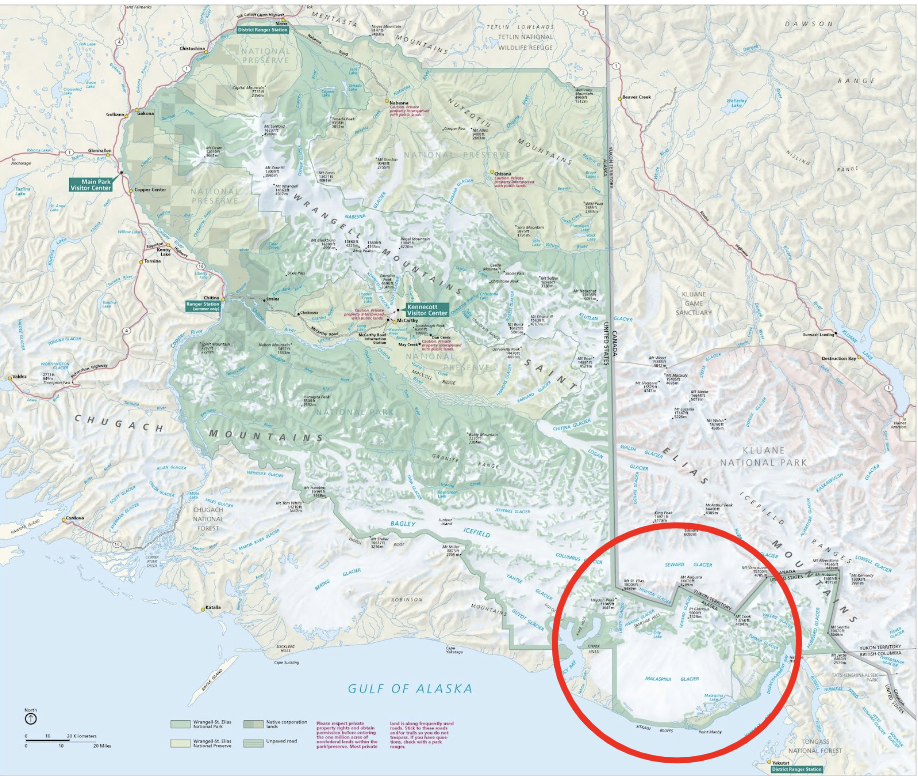Last updated: September 21, 2023
Article
Sít’ Tlein (Malaspina Glacier) Research

NPS
It’s no secret that Alaska’s glaciers are changing. Currently, Alaska glaciers are thinning at an average rate of three feet per year and contribute a significant amount to global sea level rise, spelling out big changes for ecosystems and people around the world. One of the most iconic Alaskan glaciers is Sít’ Tlein (Tlingit for “big glacier”) near the community of Yakutat, along the coastal area of Wrangell-St. Elias National Park and Preserve. Sít’ Tlein is the traditional name for what has recently been called Malaspina Glacier, the largest piedmont glacier in the world.
Anyone who has seen Sít’ Tlein knows it needs no introduction. Blue, beautiful, big, and old, this glacier has a unique personality with proglacial lakes lapping at the front of the ice and fully grown forests thriving atop frozen ice cliffs. It is an enormous piedmont-type glacier, spreading out like an icy delta at the foot of the St. Elias Mountains. This gigantic glacier is more than an interesting fact for scientists; Sít’ Tlein has a vast ice volume that, if completely melted, could cause measurable sea level rise. Previous studies showed that Sít’ Tlein is melting faster than the average Alaska glacier and is thinning rapidly.
Piedmont glaciers spill out of the mountains and pool in the valley below in spectacular glacial fans, like Malaspina. There is a large raised moraine, left over from a surging advance, which runs along the perimeter of Sít’ Tlein. This may provide a possible explanation as to why Sít’ Tlein has persisted in its current location for so long. Icy Bay and Yakutat Bay formed after Sít’ Tlein ’s tidewater sisters retreated to their current locations. Ocean terminating, or tidewater, glaciers all over Alaska have rapidly retreated in the last decades. Direct contact with ocean water, because of its relatively warm temperature compared to ice, is a powerful melting force for glaciers. Much of Malaspina terminates against this moraine or in proglacial lakes. However, recent measurements of the largest proglacial lake, Sitkagi Lagoon, show that it is almost as salty as the ocean. Because of this finding, it can be definitively said that the Sít’ Tlein is in contact with warm ocean water.
Sít’ Tlein terminates against an ancient moraine and a healthy forest grows on its ice cliffs. Recently formed proglacial lakes have exposed the glacier to ocean water, hastening its retreat. With funding from the National Science Foundation and the National Park Service, a team of scientists from the University of Alaska Fairbanks, the National Park Service, the University of Arizona, and the University of Montana have been studying Sít’ Tlein for the last two years.
The primary goal of this study is to determine whether Sít’ Tlein is at risk of rapid retreat. The research team analyzed the following questions using airborne radar and seismic sounding.
● Glacial thinning and retreat: previous studies showed that Sít’ Tlein is thinning and retreating, but how quickly are these processes evolving?
● Proglacial lakes: the lakes around Sít’ Tlein are new and growing. How will they effect glacial dynamics?
The 2023 field team includes Michael Daniel, Martin Truffer, Doug Brinkerhoff, Mikaila Mannello, Victor Devaux-Chupin, and Annegret Pohle. Field research in 2023 focused on generating a better understanding of the processes at work on the upper part of the glacier. Researchers visited Yakutat to talk about the project in April 2023. Watch the 30 minute presentation on YouTube: https://youtu.be/Y0Qc7GiScig
For questions about this research, contact lead scientist Martin Truffer at mtruffer2@alaska.edu or NPS Geologist Michael Loso at Michael_Loso@nps.gov.
Article by Kitsel Lusted, University of Alaska Fairbanks.
